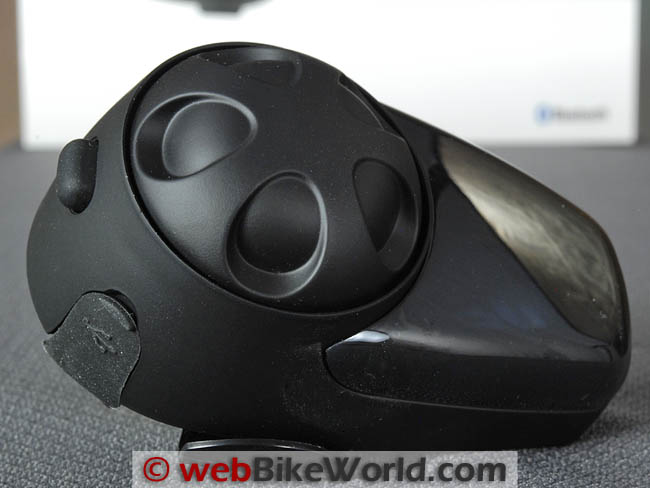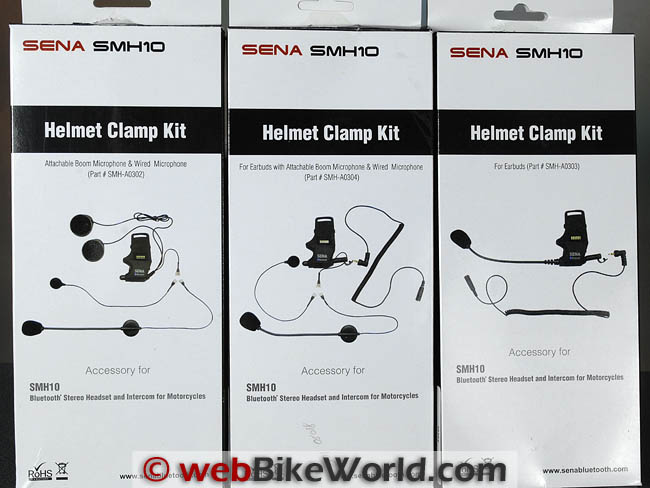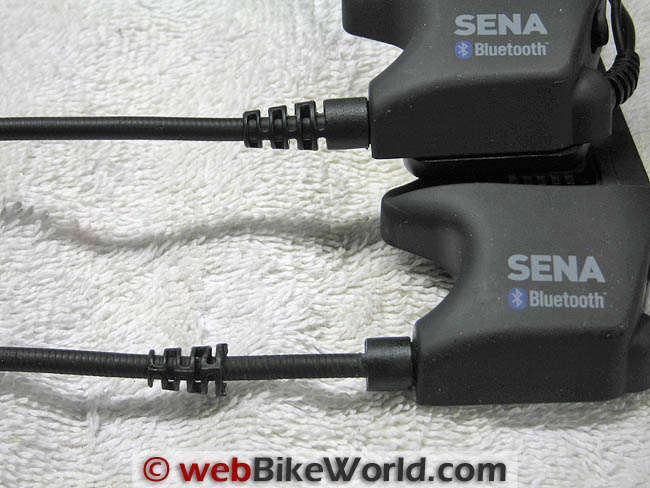5,000 Miles With the Sena SMH-10
The mainstream Cardo scala rider G4 is one of the most popular Bluetooth helmet communications systems on the market, with a loyal following around the world.
But I still see if as another leading edge example of a product whose potential has not yet been realized.
The G4 is not a failure, in fact, quite the opposite.
With a host of leading edge technologies incorporated into a robust form factor the current G4 typically deserves the accolades it gets.
But my bottom line is that I know it can and should be better at everything it is touted for.
I’m hoping that Cardo doesn’t let any of us down.
Readers will know that wBW has tracked the evolution and performance of the Cardo scala rider G4Bluetooth motorcycle communications system closely since its introduction to the public in March of 2010.
As the first software-upgradeable system on the market the feature-rich G4 was introduced with much fanfare and deservedly so: the G4 system immediately gained a higher profile than other systems then on the market.
In addition to its bells-n-whistle features the G4 also claimed an intercom range of up to one mile or 1.6 kilometres, even though typical user link ranges, with or without the extendable antenna, remains less than 1,000 metres (one kilometre) or 1,094 yards.
A key legacy issue that is a Cardo norm was also carried over; backwards compatibility with previous scala rider systems.
All in all it was understandable that the G4 quickly gained a large following that has continued to this point in time. Time and technology marches on however and since the G4 was first introduced, another global Bluetooth player, Sena Technologies, Inc. quietly entered the US market with a simpler and functionally near-perfect system.
Almost overnight the Sena SMH10 Bluetooth Intercom zoomed onto the stage, aided by internet marketing, but fully qualified by its superb class-leading intercom range (distances in excess of 1000 metres are routinely reached by this and other users) and a simple but multi-function ergonomically correct Jog Dial that is a virtual piece of industrial design art.
But the G4 didn’t fade away and continued to hold its own in a very competitive business thanks in large part to its well established marketing base, reputation, legacy support and, subsequent software/firmware releases that added significant enhancements to the G4 system.
Harking back to the time and technology theme again, early this summer Sena announced a time-limited Upgrade Program offer to current users — providing a path for owners to pay a nominal fee and in return for their original modules receive new “Version 2” components, also available to consumers in the form of a new boxed retail product.
Like the scala rider G4 system, and most other newer systems on the market, the updated Sena SMH10 now sports a USB-based interface. A USB-A to USB-Micro cable does dual duty for charging and upgrading the firmware.
So here we are with arguably the two largest players now offering owners a comparative means to upgrade, evolve and manage their individual systems over time and provide a better return on the investment dollar to boot. And yes, a detailed look at the new Sena SMH10 is pending as well…but these latest G4 units were in the queue first…

A Busy Spring for Cardo Wireless
In April of this year, Cardo announced a (new) scala rider G4 Powerset for Snowmobiles featuring some component tailoring for sled riders and passengers, supported by a specific firmware (version 3.1) and its own version 3.1 User Manual.
One of these specific features, identified in the scala rider G4 for Snowmobiles version 3.1 Release Notes (July 2011) is the ability to choose between the default Snowmobile helmet mode and Motorcycle helmet mode for multi-purpose applications, although I haven’t found any reference to this in the downloadable G4/G4 Powerset for Snowmobile User Guide.
In applauding Cardo’s initiative to cater to both the motorcycle and the snowmobile markets with discrete products, I have to also identify a related problem — even though both editions of the G4 use the same module, the firmware is not compatible. But Cardo has used the same baseline (3.+) for both.
From a software perspective, this can only cause confusion and it has. Similar but separate products with non-compatible software versions need to have their own (clearly) identifiable production coding and versioning even if based on the same chassis — configuration management tools make this a trivial internal issue, but it is another matter within a world-wide consumer market.
Bottom line: concurrent versioning and incompatibility of the software has caused confusion and functionality problems, as a number of owners have discovered, the hard way. Is this situation easy to remedy? Yes.
On another product related release, the availability of accessory kits for riders who wear half or shorty helmets has been announced. The kits are applicable to the scala rider Q2 MultiSet Pro, Q2 MultiSet, Q2 Pro, Q2 and TeamSet Pro and Teamset systems.
And finally, Spring also brought the release of the current software baseline for the motorcycle edition of the G4: PC Software Version 3.0.19; and G4 Firmware Version 3.0 (March 2011).
Outside of the aforementioned 3.1 version specific to the G4 Snowmobile system there have been no motorcycle G4 software releases since April. The current version 3.0 software was reviewed in Part IV – Software Version 3.0 Firmware Release.

Something Old for Something New
So this brings me to the present — in possession of a new Cardo Scala Rider G4 Motorcycle Powerset sent along by the Editor.
Why the new components? Both units from the original G4 Powerset kit I was using have seen continued use since March 2010, first by Rick and Burn and since then by yours truly. But earlier this summer while away on a short trip one of the modules started to degrade and then decided to just quit working.
While the jury is still out on what actually caused the failure, taking advantage of the announced two year Cardo warranty was a welcome and expedient solution. Accordingly, the Editor arranged for me to send the non-functioning G4 module back to Cardo and in return they offered up a Powerset kit which contains everything needed for two systems.
Neither the Editor or I were sure if any changes had been made since the original products were released, so the new units were given a close inspection and then compared with the one original system still on hand and still in use; typically paired to work with the compatible SCHUBERTH Rider Communications System collar installed on the SCHUBERTH C3.
In the end the only discernible change found is that the back plate of the Bluetooth module is now black which does readily set it apart from earlier systems that are all silver.
Starting with this evaluation, audio and audio management features will be under the magnifying glass in an effort to provide more objective (and subjective) evaluation information for readers.
As other systems are revisited or reviewed a comparison, possibly as a simple table initially, will be provided.
Overall headset audio in stereo or mono, evaluated in five different helmets (two flip, two full-face and one motocross-style) is very good.
But, it is not up to the audio quality provided by the Iasus GP3X2, the UClear HBC 100, the AKE HighSound Speakers or, the Sena SMH10 headset speakers that stand first, second, third and fourth respectively on my current helmet audio chart.
The G4 provides full stereo audio from the on-board FM receiver.
Tthe auxiliary MP3 jack and Bluetooth connections are A2DP compatible and provide broadcasting (streaming) A2DP/stereo audio.
Phone audio is mono.
Another audio related feature of the system that bears remembering is that the VOX circuitry is not available when using the auxiliary MP3 connection, in which case intercom sessions must be manually initiated by pressing the respective “A/B” control.
However, incoming phone calls, as the highest priority, can be answered by VOX.
Cardo uses Packet Loss Concealment or PLC technology to provide real-time audio compensation in minimizing audio loss. This technique “hides” transmission losses in a typical system where the input signal is encoded, bundled or packetized and sent over the intercom radio link to the receiver where the packet(s) are decoded and played in the receiver headset.
For VOX-based applications particularly, PLC technology is welcome although unseen or even unknown to most.
But despite some closely monitored adjustments using VOX and AGC settings there is still noticeable “clipping” of the first few words or more of an intercom session and even during an active session some clipping is still present.
From a noise perspective, there isn’t much – the G4 systems, even with a manually activated intercom link is virtually silent right out to range limits, with some of the ‘silence’ attributed to ongoing AGC monitoring and resultant volume reductions.
But on the flip side, when you want and expect a volume boost, it isn’t there, at least not until twenty to thirty seconds of continuing conversation has taken place and just when the volume is boosted, it drops off again, right in the middle of a sentence! Frustrating, you bet.

Automatic Gain Control Feature
Starting with the version 3.0 firmware upgrade, users have three adjustable automatic gain control or AGC calibration (sensitivity) settings: Low, Medium and High.
The sensitivity settings can be adjusted directly on the G4 using the Voice Configuration Menu or via the PC Application interface.
The defined AGC sensitivity conditions are:
- Low: Requires more ambient noise for activation. Examples are noisy environments and/or higher speeds.
- Medium: The default or median setting; a good start point.
- High: Requires less ambient noise for activation. Examples are quiet environments and/or lower speeds.
Even with AGC doing its thing, manual volume adjustment for each discrete audio input is possible by using the Volume Up/Down controls. AGC functions with GPS, mobile phone, other Bluetooth peripherals, intercom and auxiliary input audio on the G4 systems.
VOX Functionality
VOX or voice-activation provides a true hands-free environment. With the G4, this feature is active for voice dial and call answering or rejection. It is a user selectable setting for the intercom with changes being made via the PC application interface or directly on the G4 using the Customization Voice Menu.
As with the AGC changes made under firmware version 3.0, VOX can now also be calibrated or adjusted through Low, Medium and High sensitivity settings.
The VOX sensitivity settings are:
- Low: More noise required to activate, harder to trigger. Examples are noisier environments, higher speeds, or strong audio input.
- Medium: The default or median setting; a good start point.
- High: Less noise required to activate, easier to trigger. Examples are quieter environments, lower speeds, or weak audio input.
Don’t forget that as noted above (under System Audio) VOX functionality is disabled for the intercom when the (physical) auxiliary MP3 connection is in use, although still available for phone call audio.
Note: The PC application Help states however that VOX can be turned On or Off (for everything).
Another aspect of VOX regards its “universality” when using the intercom; if both “A” and “B” are set up and activated for multi-party purposes, VOX (if enabled) will be active on both links. The only way to have VOX on one link is to disconnect from the other.
Overall Audio Management
Using complex equipment with leading edge technology has never been much of an issue with me and I enjoy being able to explore features and capabilities of systems in order to wring the best performance from them and hopefully find the “comfort zone” that brings the big smile.
But after almost a year-and-a-half with the scala rider G4 systems, the comfort zone remains elusive and my smiles when using the G4 systems are few and far between. Finding the right VOX and AGC combination for any environment is an ongoing activity in frustration; I find the “rise” and “fall” times (probably based on sampling of the noise environment) unacceptable, especially when compared to systems such as the UClear HBC-100 and any version of the Sena SMH10.
Some of the following observations have been made previously but from a nits-and-picks perspective and to help get the message back to Cardo, they bear revisiting.
Microphone Orientation: Something that hasn’t changed, unfortunately, is the small yellow “arrow” sticker used to identify the input (mouth) side of the boom microphone. It still falls off before or shortly after first use!
Correct microphone orientation is a critical factor in getting the most out of the system so why a small raised or indented mark, or a more permanent sticker used will continue to puzzle me. A small mark made with a white permanent marker on the appropriate side of the boom cures all — many other G4 owners have done the same thing.
Headset Base Mounting Assembly: The G4 base component is easily the largest (longest at least) but it still fits right up without much fuss. The clamp or adhesive mounts work well on most helmets, although I have used 3M Dual Lock for some fitments.
Boom Mic: The 20cm or eight inch boom used by Cardo for virtually all their systems is a positive discernible feature that should be emulated by others.
Why? Well, an overly long boom assembly can be accommodated in some manner, while a shorter mic can not — especially when mounting the system on flip-up, modular or off-road style helmets with a large shell.
Auxiliary Stereo Port: Does anyone else find placement of the auxiliary stereo input jack somewhat strange? It is at odds, literally, in providing easy access. Located on the inner back side of the base the 3.5 mm stereo port can be near impossible to access especially if the base assembly fits close to the helmet, as it should.
In using the system on five different helmet types, the supplied connector cable with its 90-degree connector can usually be wiggled into place but not without putting some strain on the assembly or the port itself. The solution is to just leave the longish flex cable in place and try to safely store it.
An alternative now used is a short male/female extender cable with the requisite 90-degree connector; when not in use this short cable is tucked under the neck-roll of the helmet or close at hand in a pocket.
Audio Management: Continues to be a frustration with me, acknowledging that I am demanding and with access to so many other systems, shortfalls in the G4 regarding audio gain and voice activation become very noticeable. The G4 also lags in audio fidelity when compared to so many other systems.
Conclusion
No matter how much time I spend with the G4 systems my “comfort zone” isn’t realized. I use and evaluate a lot of Bluetooth helmet systems and although the G4 systems work, I can’t seem to find the right combination of environment, helmet and settings to convince me that the G4 is the superior system on the market.
But having said that, I’m anticipating a major release from Cardo later this fall and it will likely clean up current issues reported by users and add some enhancements, possibly related to additional channels for intercom and peripheral pairing enhancements.
Sometimes “feature-rich” is not the solution and what is provided needs to work. With release of the new USB-based and software upgradeable Sena SMH10 product, the challenge has been put out there and I know the yardstick is going to get moved forward, so expect some response from Cardo.
And on a parting note, once the Sena SMH10 version two systems has been put through their initial evaluation gauntlet, a head-to-head, control-to-control comparison with the G4 is in the works.

